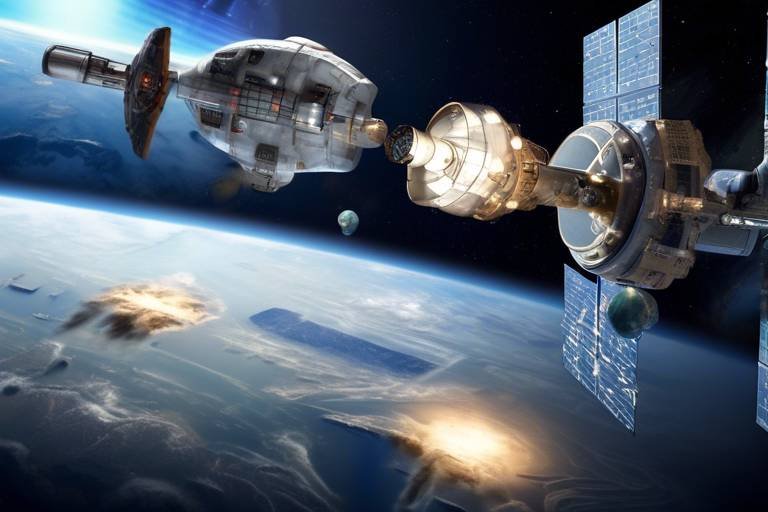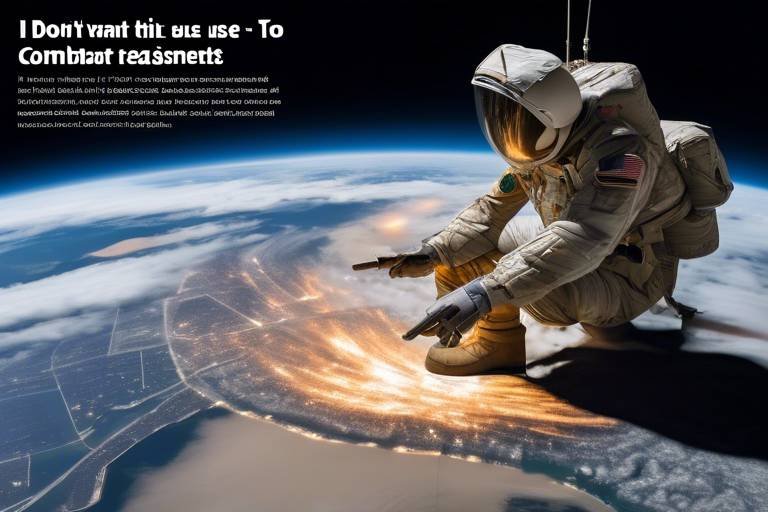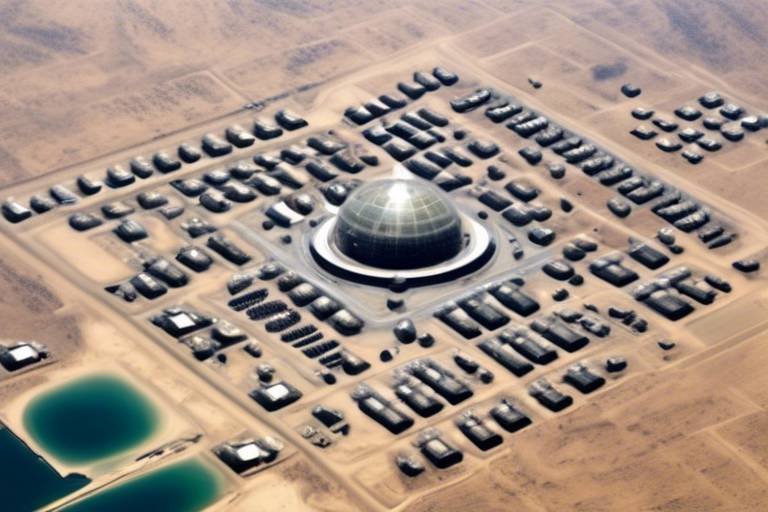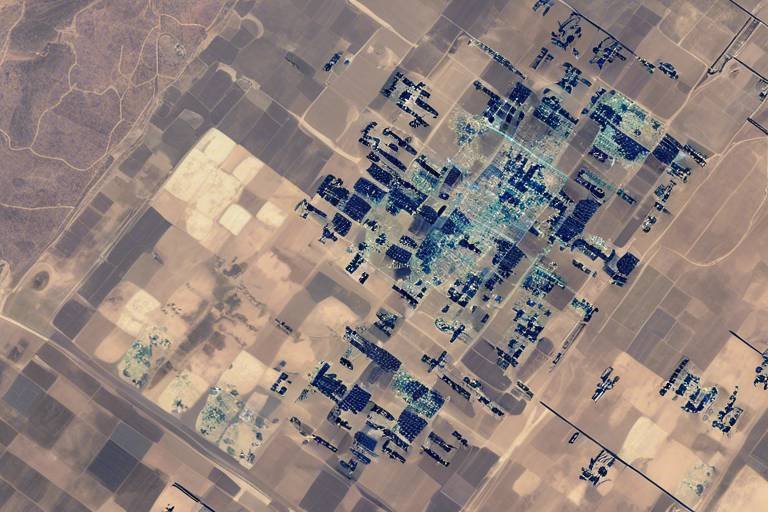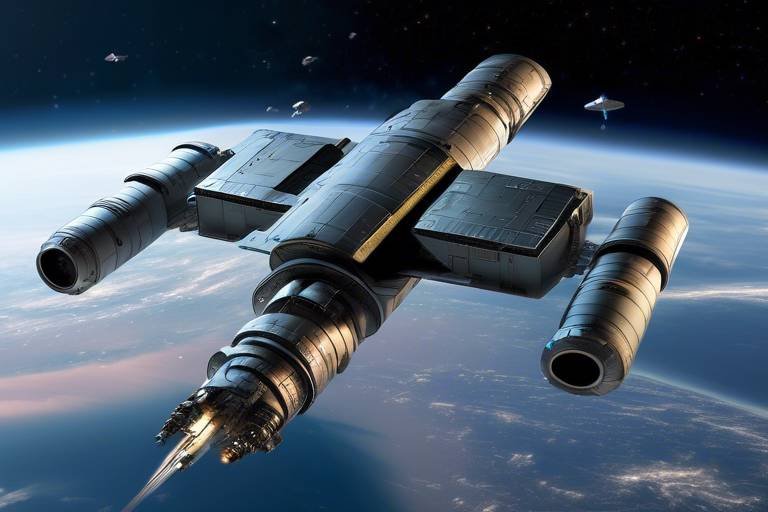How Satellites Aid in Decision-Making for Military Leaders
The world of military operations has evolved tremendously over the years, and one of the most significant advancements has been the integration of satellite technology into decision-making processes. Imagine a chess game where every piece is equipped with a live feed of the opponent's moves—this is essentially how satellites empower military leaders. They provide a bird's-eye view of the battlefield, enabling commanders to make informed decisions based on real-time data. This article delves into the critical role of satellites in enhancing military decision-making, shedding light on various technologies and their applications in strategic operations.
In today's fast-paced military environment, the ability to access real-time information is paramount. Satellites serve as the backbone of modern military strategy, offering invaluable data that informs tactical decisions and enhances operational effectiveness across multiple domains. Whether it's monitoring troop movements, assessing enemy positions, or coordinating logistics, satellites deliver a wealth of information that is crucial for success. The integration of satellite data into military operations has transformed how leaders plan and execute missions, making it possible to anticipate challenges and respond swiftly.
Not all satellites are created equal; different types serve distinct functions that are vital for military operations. Understanding these various types of military satellites can illuminate their individual contributions to a comprehensive understanding of the battlefield. Here are the primary categories:
- Reconnaissance Satellites: Designed to gather intelligence through high-resolution imaging.
- Communication Satellites: Facilitate secure communication among military units.
- Navigation Satellites: Provide precise positioning data essential for operations.
Reconnaissance satellites are the eyes in the sky, capturing crucial intelligence by taking high-resolution images of enemy positions, terrain, and movements. This capability allows military leaders to make informed decisions based on accurate and current data. Think of these satellites as the ultimate surveillance tool, providing a panoramic view of the battlefield that ground troops simply cannot achieve.
Equipped with advanced imaging technologies, reconnaissance satellites can observe and analyze vast areas with remarkable detail. They can operate in various spectrums, including visible light, infrared, and radar, which enables them to gather data regardless of the time of day or weather conditions. This level of detail is essential for military leaders who need to understand the enemy's capabilities and intentions.
However, it's not all smooth sailing. Despite their sophisticated technology, reconnaissance satellites face challenges that can impact their effectiveness. Weather conditions like clouds or storms can obscure their view, and technological limitations may hinder data collection. Moreover, the sheer volume of data generated can overwhelm analysts, making it challenging to distill actionable insights in a timely manner.
Communication satellites are another cornerstone of military operations. They enable secure and reliable communication among military units, ensuring that leaders can coordinate operations effectively and maintain command and control. Imagine trying to orchestrate a complex dance without being able to hear the music—communication satellites ensure that every unit is in sync, allowing for a seamless execution of strategies.
Navigation satellites, particularly those utilizing the Global Positioning System (GPS), are vital for military operations. They provide precise positioning data that enhances the accuracy of strikes and troop movements in dynamic environments. The importance of accurate navigation cannot be overstated; it allows ground forces to maneuver effectively, improving operational success rates and minimizing risks during missions.
With accurate navigation data, ground forces can execute maneuvers with confidence. This leads to improved operational success rates, as troops can avoid obstacles and make real-time adjustments based on the battlefield's fluid nature. The ability to pinpoint locations accurately can mean the difference between mission success and failure.
The integration of satellite data with other technologies, such as drones and ground sensors, creates a comprehensive operational picture. This synergy empowers military leaders to make timely and informed decisions that can alter the course of engagements. Just like a conductor leading an orchestra, satellite data harmonizes various elements of military strategy to produce a cohesive and effective operational plan.
- How do satellites improve military communication?
Satellites provide secure channels for communication, allowing for real-time updates and coordination among different military units. - What are the limitations of reconnaissance satellites?
Weather conditions and technological constraints can affect the accuracy and timeliness of the data collected by reconnaissance satellites. - How does GPS impact military operations?
GPS provides precise location data, enhancing the accuracy of troop movements and strike operations, ultimately improving mission success rates.
The Role of Satellites in Military Strategy
In today's fast-paced world, where information is power, satellites have emerged as a backbone of modern military strategy. Imagine being able to see the entire battlefield from above, gathering real-time intelligence that can make or break a mission. This is precisely what satellites do—they provide a bird's-eye view of operations, allowing military leaders to make informed decisions swiftly and efficiently. The ability to access real-time data means that commanders can adjust their strategies on the fly, responding to threats and opportunities as they arise.
Satellites play a multifaceted role in military operations, encompassing various domains such as reconnaissance, communication, and navigation. Each of these functions is crucial for creating a comprehensive operational strategy. For instance, reconnaissance satellites capture high-resolution images that reveal enemy movements and terrain, while communication satellites ensure that troops remain connected, even in the most remote locations. Navigation satellites, like GPS, provide precise positioning data that is essential for coordinating ground operations.
Furthermore, the integration of satellite technology with other military assets enhances operational effectiveness. By combining satellite data with information from drones and ground sensors, military leaders can create a robust operational picture that improves situational awareness. This interconnectedness allows for a more agile response to dynamic battlefield conditions, ensuring that forces can adapt to changing scenarios.
However, the reliance on satellites also introduces challenges. Weather conditions can obscure satellite imagery, and technological limitations may hinder data accuracy. Despite these obstacles, the advantages of satellite technology in military strategy are undeniable. The ability to gather and analyze vast amounts of data in real-time empowers military leaders, allowing them to make decisions that can save lives and achieve strategic objectives.
In summary, satellites are not just tools; they are essential components of a successful military strategy. They transform how commanders view the battlefield, enabling them to make decisions with a level of precision and speed that was previously unimaginable. As technology continues to evolve, the role of satellites in military operations will only become more significant, shaping the future of warfare.
Types of Military Satellites
When it comes to military operations, not all satellites are created equal. Each type of military satellite plays a unique role, serving distinct functions that are crucial for effective decision-making on the battlefield. Understanding these types can provide valuable insights into how military leaders utilize space technology to gain an advantage. The primary categories include reconnaissance satellites, communication satellites, and navigation satellites. Each of these types offers specific capabilities that enhance situational awareness and operational effectiveness.
Reconnaissance satellites are perhaps the most well-known type. These satellites are equipped with advanced imaging technologies that allow them to capture high-resolution images of enemy positions, terrain, and troop movements. Imagine a bird’s-eye view of the battlefield; that’s what these satellites provide. They can cover vast areas and deliver real-time data, enabling military leaders to make informed decisions based on accurate intelligence. However, their effectiveness can be hampered by factors such as weather conditions and technological limitations, which can impact the clarity and timeliness of the data they collect.
On the other hand, communication satellites are the backbone of military coordination. They facilitate secure and reliable communication among various military units, ensuring that leaders can effectively coordinate operations in real time. Without these satellites, the chaos of the battlefield could lead to miscommunication and operational failures. Communication satellites ensure that every command and update is transmitted swiftly, allowing for seamless collaboration among ground forces, air support, and naval units.
Then we have navigation satellites, such as those that make up the Global Positioning System (GPS). These satellites are vital for military operations, providing precise positioning data that enhances the accuracy of strikes and troop movements. Imagine trying to navigate through a dense forest without a map or GPS; it would be nearly impossible. The same goes for military operations in unfamiliar terrain. Accurate navigation data allows ground forces to maneuver effectively, improving operational success rates while minimizing risks during missions.
To illustrate the differences and roles of these satellites, here's a brief comparison:
| Type of Satellite | Primary Function | Key Features |
|---|---|---|
| Reconnaissance | Gather intelligence | High-resolution imaging, real-time data |
| Communication | Facilitate secure communication | Reliable data transmission, secure channels |
| Navigation | Provide positioning data | GPS accuracy, real-time location tracking |
In addition to these primary types, there are also specialized satellites that serve niche roles, including weather satellites that provide crucial data on environmental conditions, and electronic intelligence satellites that monitor communications and radar signals. Each type of satellite, whether it’s gathering images, relaying messages, or pinpointing locations, contributes to a comprehensive understanding of the battlefield.
In conclusion, the diverse types of military satellites play an indispensable role in modern warfare. By integrating the capabilities of reconnaissance, communication, and navigation satellites, military leaders can create a cohesive strategy that enhances their operational effectiveness. As technology continues to advance, the importance of these satellites will only grow, making them a cornerstone of military decision-making.
Reconnaissance Satellites
play a pivotal role in modern military operations, acting as the eyes in the sky that provide critical intelligence about enemy activities and terrain. These high-tech marvels are equipped with cutting-edge imaging technologies that allow them to capture high-resolution images from space. Imagine having a bird’s-eye view of the battlefield, where every detail—from troop movements to supply lines—can be monitored in real-time. This capability is not just a luxury; it is a necessity for military leaders who need to make informed decisions swiftly and effectively.
The primary function of reconnaissance satellites is to gather intelligence that informs strategic planning and operational execution. By analyzing the data collected, military leaders can assess the strengths and weaknesses of enemy forces, identify potential threats, and determine the best course of action. The information obtained can be used for a variety of purposes, including:
- Monitoring enemy troop movements
- Assessing the effectiveness of military operations
- Identifying key infrastructure and logistics routes
One of the standout features of reconnaissance satellites is their ability to cover vast areas in a relatively short period. This capability is made possible through advanced imaging technologies, such as synthetic aperture radar (SAR) and electro-optical sensors. These technologies enable satellites to penetrate cloud cover and gather data during both day and night, ensuring that military leaders have access to timely and accurate information.
However, operating reconnaissance satellites is not without its challenges. Weather conditions, such as heavy cloud cover or storms, can significantly impact the quality of the images captured. Additionally, technical limitations, such as sensor resolution and data transmission delays, can hinder the effectiveness of reconnaissance efforts. For instance, if a satellite is unable to capture clear images due to adverse weather, military planners may have to rely on outdated or incomplete information, which could lead to poor decision-making.
Despite these challenges, the advantages of reconnaissance satellites far outweigh the drawbacks. They provide a level of situational awareness that is crucial for successful military operations. By integrating satellite data with other intelligence sources, such as ground reconnaissance and signals intelligence, military leaders can develop a comprehensive understanding of the battlefield. This integration not only enhances the accuracy of assessments but also allows for more effective planning and execution of military strategies.
In summary, reconnaissance satellites are indispensable tools in the arsenal of modern military operations. Their ability to provide real-time, high-resolution intelligence enables military leaders to make informed decisions that can mean the difference between success and failure on the battlefield. As technology continues to advance, the capabilities of these satellites will only improve, further solidifying their role as a cornerstone of military strategy.
Capabilities of Reconnaissance Satellites
Reconnaissance satellites are often dubbed the "eyes in the sky" for military leaders, and for good reason. These sophisticated machines are equipped with cutting-edge imaging technologies that allow them to capture high-resolution images of vast areas on the Earth's surface. Imagine being able to zoom in on a target from hundreds of miles away; that's the power these satellites wield. They not only provide images but also gather various types of data, including infrared and radar information, which are crucial for understanding the battlefield dynamics.
One of the most impressive capabilities of reconnaissance satellites is their ability to operate in various conditions and times of day. Whether it's bright daylight or the pitch-black of night, these satellites can still deliver valuable intelligence. For instance, they can use synthetic aperture radar (SAR) to penetrate cloud cover and gather data even in adverse weather conditions. This means that military leaders can rely on consistent and reliable information, regardless of external factors that might hinder ground operations.
Moreover, the data collected by reconnaissance satellites is processed and analyzed using advanced algorithms and artificial intelligence, making it possible to identify and track enemy movements with remarkable accuracy. This level of detail allows commanders to anticipate actions, plan countermeasures, and ultimately make informed decisions that can turn the tide of battle. The integration of this data into command and control systems ensures that military leaders have a comprehensive view of the operational environment.
For a clearer understanding, let’s look at some of the key capabilities of reconnaissance satellites:
- High-Resolution Imaging: Captures detailed images that help in assessing enemy positions and infrastructure.
- Multi-Spectral Sensing: Gathers data across various wavelengths, providing insights into different environmental conditions.
- Real-Time Data Transmission: Sends information back to command centers almost instantaneously, allowing for rapid decision-making.
- Global Coverage: Can monitor large geographical areas, ensuring no movement goes unnoticed.
In summary, the capabilities of reconnaissance satellites are not just about gathering images; they represent a critical component of modern military strategy. By providing real-time, high-resolution data, these satellites empower military leaders to make tactical decisions with a level of confidence that was previously unimaginable. As technology continues to evolve, we can expect even more advanced capabilities to emerge, further enhancing the effectiveness of military operations.
Q1: How do reconnaissance satellites differ from regular satellites?
A1: Reconnaissance satellites are specifically designed for military purposes, focusing on gathering intelligence and surveillance data, while regular satellites may serve various civilian functions, such as weather monitoring or telecommunications.
Q2: Can reconnaissance satellites operate in bad weather?
A2: Yes, many reconnaissance satellites are equipped with technologies like synthetic aperture radar, which allows them to collect data even in adverse weather conditions, such as cloud cover or rain.
Q3: How often do reconnaissance satellites pass over the same area?
A3: The frequency of passes depends on the satellite's orbit and mission parameters, but many reconnaissance satellites can revisit the same area multiple times a day to provide updated intelligence.
Q4: What types of data can reconnaissance satellites collect?
A4: They can collect various types of data, including high-resolution images, infrared data, and signals intelligence, which can be used for a comprehensive understanding of the battlefield.
Challenges in Reconnaissance
While reconnaissance satellites are pivotal in gathering intelligence, they are not without their challenges. One of the primary obstacles is the impact of weather conditions. For instance, heavy cloud cover or storms can obscure visibility, rendering high-resolution imaging ineffective. Imagine trying to take a clear photograph during a downpour; the same principle applies to these satellites. When the skies are cloudy, the data collected can be compromised, leading to potential gaps in intelligence that could affect mission planning.
Another significant challenge lies in the technological limitations of the satellites themselves. Although many reconnaissance satellites are equipped with advanced sensors and imaging technologies, there are still limitations in terms of resolution and the ability to capture real-time data. For example, some satellites may only be able to provide images at certain intervals, which can delay decision-making in fast-paced military scenarios. This lag can be likened to trying to watch a live sports game on a delayed broadcast—by the time you see the action, it’s already happened, and you’ve missed out on crucial details.
Moreover, enemy countermeasures pose a considerable threat to the effectiveness of reconnaissance satellites. Adversaries may employ tactics such as electronic warfare to jam signals or deploy stealth technology to evade detection. This cat-and-mouse game between military forces can significantly hinder the ability of reconnaissance satellites to provide accurate and timely data. The battlefield is not just a physical space; it’s also a technological arena where information warfare plays a crucial role.
Lastly, the sheer volume of data collected by these satellites can be overwhelming. Military analysts must sift through massive amounts of information to extract actionable intelligence. This process can be time-consuming and prone to human error, potentially leading to misinterpretations or missed opportunities. Imagine trying to find a needle in a haystack; without the right tools and processes, critical insights may be overlooked.
In summary, while reconnaissance satellites are invaluable assets in military operations, they face a range of challenges that can impact their effectiveness. From environmental factors to technological constraints and the complexities of data analysis, military leaders must navigate these hurdles to leverage satellite intelligence successfully.
- What are reconnaissance satellites? Reconnaissance satellites are designed to gather intelligence by capturing high-resolution images and data about enemy positions and movements.
- How do weather conditions affect reconnaissance? Adverse weather, such as cloud cover or storms, can obstruct visibility, making it difficult for satellites to capture clear images.
- What technological limitations do reconnaissance satellites face? Limitations include resolution constraints and the inability to provide real-time data, which can delay critical decision-making.
- How do enemy countermeasures impact reconnaissance? Adversaries may use electronic warfare and stealth technology to evade detection, complicating intelligence gathering.
- What challenges arise from data analysis in reconnaissance? The vast amount of data collected can overwhelm analysts, leading to potential misinterpretations or missed insights.
Communication Satellites
Communication satellites are the backbone of modern military operations, providing a secure and reliable communication network that is crucial for the success of missions. Imagine being in the heat of battle, where every second counts, and having the ability to communicate instantly with your team across vast distances. This is the reality that communication satellites create for military leaders, allowing them to coordinate strategies and share vital information in real-time.
These satellites operate in various orbits and utilize different frequencies to ensure that communication remains uninterrupted, even in the most challenging environments. By using advanced technologies such as frequency hopping and encryption, they protect sensitive information from adversaries, making it incredibly difficult for enemies to intercept communications. This layer of security is essential for maintaining the element of surprise and safeguarding operational plans.
Moreover, communication satellites facilitate a wide array of functionalities, including:
- Voice Communication: Enabling clear and direct conversations between ground forces and command centers.
- Data Transmission: Sending critical intelligence reports, maps, and operational updates swiftly and securely.
- Video Conferencing: Allowing commanders to visually assess situations and make informed decisions based on real-time footage.
In essence, communication satellites not only enhance the efficiency of military operations but also play a pivotal role in ensuring that leaders have the most up-to-date information at their fingertips. The ability to communicate seamlessly across different branches of the military—land, air, and sea—creates a unified front that is essential for effective decision-making.
However, the reliance on these advanced technologies does come with its own set of challenges. For instance, the vulnerability to cyber attacks poses a significant threat, as adversaries may attempt to jam signals or hack into communication networks. Additionally, the physical infrastructure that supports these satellites must be constantly monitored and maintained to prevent failures that could jeopardize operations.
Despite these challenges, the advantages provided by communication satellites far outweigh the risks. They enable military leaders to maintain command and control even in the most chaotic situations, ensuring that every decision made is informed and strategic. As technology continues to evolve, we can only expect communication satellites to become even more sophisticated, further enhancing their role in military operations.
- What is the primary function of communication satellites in the military? Communication satellites provide secure communication channels that allow military leaders to coordinate operations and share critical information in real-time.
- How do communication satellites ensure data security? They utilize advanced technologies such as encryption and frequency hopping to protect sensitive information from interception.
- What are some challenges faced by communication satellites? Challenges include vulnerability to cyber attacks and the necessity for constant monitoring and maintenance of the supporting infrastructure.
- Can communication satellites be used for purposes other than military operations? Yes, communication satellites are also used for commercial purposes, including telecommunications, broadcasting, and internet services.
Navigation and Positioning Systems
Navigation satellites, particularly the Global Positioning System (GPS), play a crucial role in modern military operations. These satellites provide precise positioning data that is essential for a variety of tasks, from coordinating troop movements to executing air strikes. Imagine trying to navigate a dense forest without a map or compass; it would be nearly impossible to find your way. This is similar to what military leaders face on the battlefield without accurate navigation data. The precision offered by navigation satellites ensures that ground forces can maneuver effectively, significantly enhancing their operational success rates.
The impact of navigation and positioning systems extends beyond just guiding troops. They allow for real-time adjustments during missions, enabling military leaders to respond swiftly to changing conditions on the ground. For instance, if a unit encounters unexpected enemy resistance, the ability to quickly recalibrate their position and adjust their strategy can mean the difference between success and failure. This agility is vital in dynamic combat environments where every second counts.
Additionally, the integration of navigation systems with other technologies amplifies their effectiveness. For example, when combined with aerial drones, these systems can provide real-time intelligence while also directing strikes with pinpoint accuracy. This synergy between different technologies creates a comprehensive operational picture, empowering military leaders to make timely and informed decisions. The table below illustrates some key features and benefits of navigation and positioning systems in military operations:
| Feature | Description | Benefits |
|---|---|---|
| Precision | High accuracy in location data | Improves strike accuracy and troop movements |
| Real-time Data | Instant updates on positioning | Enhances responsiveness to battlefield changes |
| Integration | Works with drones and ground sensors | Provides a comprehensive operational picture |
| Global Coverage | Access from anywhere on Earth | Ensures continuous operational capability |
However, it’s important to recognize that these systems are not without their challenges. Factors such as satellite signal interference, physical obstructions, and even cyber threats can compromise the reliability of navigation data. Military leaders must remain vigilant and adaptable, employing backup systems and alternative strategies to mitigate these risks. In essence, while navigation and positioning systems are invaluable assets in military operations, their effectiveness hinges on a robust understanding of their limitations and the environment in which they are deployed.
As we continue to advance technologically, the future of navigation and positioning systems looks promising. Innovations like multi-constellation GNSS (Global Navigation Satellite System) and enhanced ground-based augmentation systems are set to further improve the accuracy and reliability of these critical tools. The military's ability to leverage these advancements will undoubtedly shape the landscape of modern warfare, making effective navigation a cornerstone of successful military strategy.
- What are navigation and positioning systems?
Navigation and positioning systems, such as GPS, provide precise location data essential for military operations.
- How do these systems improve military operations?
They enhance the accuracy of troop movements and strike operations, allowing for real-time adjustments and improved decision-making.
- What challenges do navigation systems face?
Challenges include signal interference, physical obstructions, and potential cyber threats that can affect data reliability.
- What is the future of navigation systems in the military?
The future includes advancements like multi-constellation GNSS and better ground-based systems, enhancing accuracy and reliability.
Impact on Ground Operations
The integration of satellite technology into military ground operations has revolutionized the way forces engage in combat and manage logistics. Imagine trying to navigate a maze blindfolded; that’s what ground troops faced before the advent of precise satellite navigation. Now, with the power of satellites, they have a clear map that not only shows their current position but also highlights the locations of friendly forces, potential threats, and strategic objectives. This enhanced situational awareness is crucial for making split-second decisions that can mean the difference between success and failure on the battlefield.
One of the most significant impacts of satellite navigation is its effect on troop movements. With accurate positioning data, military leaders can coordinate troop deployments with pinpoint precision. This means that forces can maneuver into position quickly and efficiently, reducing the likelihood of friendly fire incidents and improving overall operational success rates. For instance, during joint operations, satellite data allows different branches of the military to work in harmony, as they can share real-time information about troop locations and movements. The result? A well-orchestrated operation that maximizes the strengths of each unit involved.
Moreover, the ability to receive real-time intelligence directly from satellites enhances ground operations by allowing commanders to adjust their strategies on the fly. If a reconnaissance satellite identifies an enemy stronghold, ground forces can be redirected to either engage or bypass the location, depending on the mission's objectives. This adaptability is essential in modern warfare, where conditions can change rapidly, and the ability to pivot can lead to mission success.
To illustrate this further, consider the following table that outlines the key benefits of satellite technology on ground operations:
| Benefit | Description |
|---|---|
| Enhanced Situational Awareness | Provides real-time data on troop locations and enemy movements. |
| Improved Coordination | Facilitates seamless communication among different military branches. |
| Increased Operational Success | Allows for precise troop maneuvers, reducing the risk of errors. |
| Adaptability | Enables quick adjustments to strategies based on real-time intelligence. |
However, it’s important to acknowledge that while satellite technology greatly enhances ground operations, it is not without its challenges. For example, reliance on satellite data can create vulnerabilities. If adversaries employ jamming techniques or cyberattacks to disrupt satellite communications, it can severely hinder military operations. Therefore, while satellites provide a significant advantage, military leaders must also develop contingency plans to mitigate these risks.
In conclusion, the impact of satellite technology on ground operations is profound and multifaceted. By providing accurate navigation, facilitating communication, and enhancing situational awareness, satellites empower military leaders to make informed decisions quickly. As technology continues to evolve, the role of satellites in military strategy will only become more critical, ensuring that ground forces remain agile and effective in the face of ever-changing battlefield dynamics.
- How do satellites improve communication in military operations?
Satellites provide secure and reliable communication channels between military units, ensuring that leaders can coordinate actions effectively and maintain command and control during operations. - What are the main types of military satellites?
The main types of military satellites include reconnaissance satellites, communication satellites, and navigation satellites, each serving distinct functions in enhancing military capabilities. - Can satellite data be compromised?
Yes, satellite communications can be vulnerable to jamming and cyberattacks, which is why military leaders must have backup systems and contingency plans. - How do reconnaissance satellites gather intelligence?
Reconnaissance satellites use advanced imaging technologies to capture high-resolution images of enemy positions and terrain, providing crucial intelligence for military operations.
Integration with Other Technologies
In the fast-paced world of military operations, the integration of satellite data with other cutting-edge technologies is not just beneficial; it’s essential. Imagine a symphony where each instrument plays its part in harmony, creating a powerful performance that captivates the audience. Similarly, when satellites work in concert with drones, ground sensors, and advanced data analytics, they create a comprehensive operational picture that is invaluable to military leaders. This integration allows for a **synergistic effect**, enhancing situational awareness and enabling more effective decision-making.
For instance, when reconnaissance satellites capture high-resolution images, these images can be transmitted in real-time to unmanned aerial vehicles (UAVs), commonly known as drones. Drones can then be deployed to investigate specific areas of interest identified by the satellites. This not only saves time but also provides a **layered approach** to intelligence gathering, allowing military leaders to assess threats from multiple angles. The ability to combine satellite imagery with drone reconnaissance significantly improves the accuracy of intelligence, ensuring that decisions are made based on the most current data available.
Moreover, ground sensors play a crucial role in this integration. These sensors can detect movement, changes in the environment, or even communications from enemy units. When this data is fed into the satellite systems, it creates a **real-time feedback loop** that enhances the overall understanding of the battlefield. Military leaders can quickly adapt their strategies based on the information gathered, making them more agile and responsive to changing conditions.
To illustrate the impact of this integration, consider the following table that outlines how different technologies complement each other:
| Technology | Function | Benefits |
|---|---|---|
| Reconnaissance Satellites | Capture high-resolution images | Provides accurate situational awareness |
| Drones | Conduct aerial surveillance | Offers real-time data collection and threat assessment |
| Ground Sensors | Detect movement and communications | Enhances battlefield awareness and response time |
| Data Analytics | Process and analyze information | Transforms raw data into actionable intelligence |
This seamless integration of technologies not only enhances the effectiveness of military operations but also **reduces risks**. By having a well-rounded understanding of the battlefield, military leaders can make informed decisions that minimize the chances of unexpected outcomes. It’s akin to having a GPS system that not only shows you the route but also alerts you to potential traffic jams and road closures, allowing you to adjust your path accordingly.
As we move forward, the significance of integrating satellite data with other technologies will only increase. The battlefield of the future will require a **multifaceted approach**, where information flows effortlessly between various platforms, ensuring that military leaders are always one step ahead. This interconnectedness will ultimately lead to more successful missions and enhanced safety for military personnel.
- How do satellites improve military communication? Satellites enable secure and reliable communication channels between military units, ensuring that information flows seamlessly across various levels of command.
- What are the limitations of reconnaissance satellites? Weather conditions, technological limitations, and the need for timely data can impact the effectiveness of reconnaissance satellites.
- How does GPS enhance military operations? GPS provides precise positioning data, which is crucial for accurate strikes and troop movements, especially in dynamic environments.
- Can satellite data be used in civilian applications? Yes, satellite data has numerous civilian applications, including disaster response, urban planning, and environmental monitoring.
Frequently Asked Questions
- How do satellites enhance military decision-making?
Satellites provide real-time data and intelligence that are crucial for tactical decisions. They help military leaders understand the battlefield by offering insights into enemy positions and movements, which ultimately enhances operational effectiveness.
- What types of military satellites are there?
There are several types of military satellites, including reconnaissance satellites for intelligence gathering, communication satellites for secure communications, and navigation satellites like GPS that provide precise positioning data. Each type plays a unique role in military operations.
- What capabilities do reconnaissance satellites have?
Reconnaissance satellites are equipped with advanced imaging technologies that allow them to capture high-resolution images of vast areas. This capability enables military leaders to gain essential situational awareness and make informed decisions based on accurate data.
- What challenges do reconnaissance satellites face?
Despite their advanced technology, reconnaissance satellites encounter challenges such as adverse weather conditions and technological limitations that can affect the accuracy and timeliness of the data they collect.
- How do communication satellites support military operations?
Communication satellites ensure secure and reliable communication among military units. They allow leaders to coordinate operations effectively, maintaining command and control even in challenging environments.
- Why are navigation satellites important for military operations?
Navigation satellites, particularly GPS, provide precise positioning data that is essential for the accuracy of strikes and troop movements. This precision helps ground forces maneuver effectively and reduces risks during missions.
- How does satellite data integrate with other technologies?
Satellite data can be integrated with other technologies, such as drones and ground sensors, to create a comprehensive operational picture. This integration empowers military leaders to make timely and informed decisions, enhancing overall mission success.



